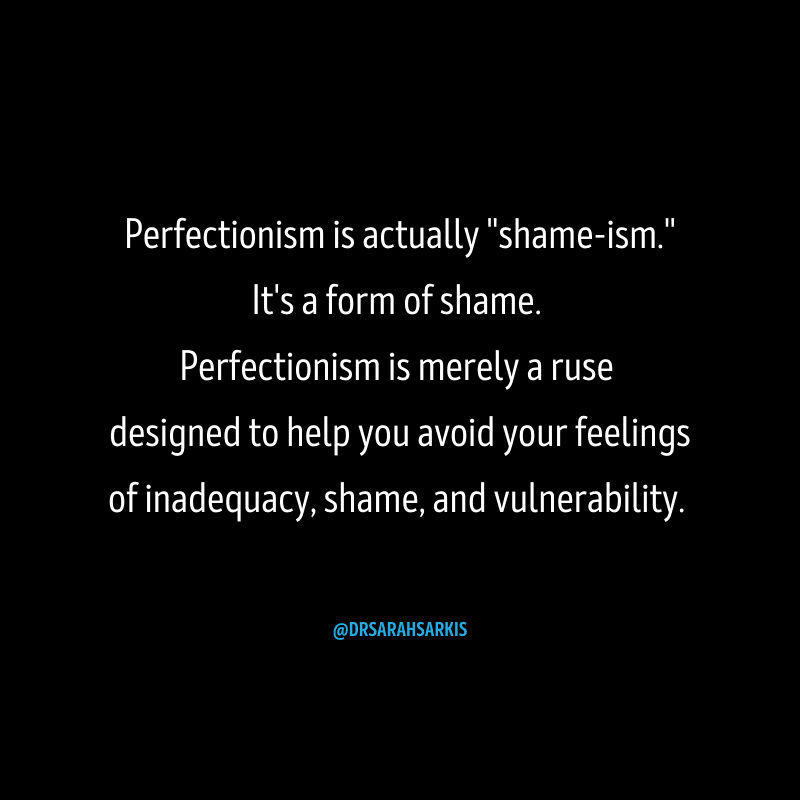I contemplated including this discussion of perfectionism in my last blog, Deconstructing Anxiety, especially because of its relationship to anxiety, but as I unraveled the intricacies, it was clear it was a topic unto itself.
I’ll point out the obvious right off the top: Perfectionism is often applauded in our society and I get it. I am someone who is steeped in the art of achievement and accomplishment. I speak that language, intimately, and I have been in the vice grip that is the pursuit of perfection at various times throughout my journey and in various domains of my being. The pursuit of perfection can take on many different roles and styles of expression. Additionally, gender influences the expression of perfection in our society. In my practice, I have become more skilled at identifying the different and unique ways that men and women express this behavior.
For a lot of women, it’s a physical epidemic that is acted out upon our bodies. We drive ourselves to look a certain way, fit a certain size, and conform to the norms of a society that still judges women very much through currency of beauty and desirability. Motherhood is also ripe with opportunities to unleash our pursuit for being the “perfect mom.” When we inevitably fall short of this fictitious goal, we are riddled with guilt. It’s at the root of the disease to please; the instinct to say yes to everything for fear of letting anyone down.
For men, perfection is translated into a pursuit for power, in all the dubious ways that tends to be expressed. I often find the seeds of perfectionism expressed through excessive focus on sex. In this expression, sex becomes a metaphor for virulence and power and, therefore, psychologically and emotionally fused with a sense of masculinity and conquest. There are, of course, the more obvious masculine expressions as well, such as the accumulation of material acquisitions, usually monetarily based, etc. In my experience, working intimately with men, when you get below the surface, all of these behaviors orbit in and around the expression of power, which is how men translate the pursuit of perfection.
Sometimes perfectionism reveals itself in more obvious ways. I hear people describe themselves as a perfectionist or needing things to be perfect. Sometimes I hear people reference it in relation to their homes or their clothes or the way their cars need to be kept. From a diagnostic standpoint, when oppressive, these rigid standards of cleanliness, order, and organization are referred to as Obsessive Compulsive Personality Disorder (OCPD). OCPD should not be confused with Obsessive Compulsive Disorder (OCD), which involves repetitive thoughts (obsessions) and behaviors or rituals (compulsions) in order to avoid the anxiety that something catastrophic will happen if the ritual is disrupted. Both OCPD and OCD are related to and act in defense of anxiety (and feelings in general). In other words, the uncomfortable feelings, be it anxiety or otherwise, are significantly reduced in response to the ritual (OCD) or our home being excessively tidy or orderly (OCPD).
From a therapeutic standpoint, we could stay at the surface level and poke around the behavioral aspects of perfectionism, but that doesn’t really tell us all that much.
The core emotional intersection that fuels the behavior of perfectionism is most often related to shame.
Perfectionism is actually a relationship with shame– that’s why I encourage all of the people I work with to refer to it as “shame-ism” vs perfectionism. Often it doesn’t surface for many years, decades even, only after all the accomplishments, the conquests, the monetary victories, and the aesthetic achievements have been dominated and conquered, and yet a sense of emptiness remains. People often land in my office after decades of achievement and still a discomfort, a lack of fulfillment, and an emotional hollowness prevails. It is then that we begin to contemplate that perfectionism is a form of shame. It’s a ruse designed to help you avoid your feelings of inadequacy, shame, and vulnerability. It’s the scar tissue of developmental traumas that we act out upon ourselves in an effort to prove our worthiness. The pursuit of perfection or power keeps us from having to feel our most intimate and often emotionally disorienting feelings.

Some of you reading this are probably thinking, if I stop being a perfectionist, my career will suffer, I’ll make less money, I’ll have less drive. But that’s not true. Achievement and drive stand apart from the shame-based pursuit of perfection. Perfection is a never-ending loop of internal dialogue that has many people trapped in a cycle of striving for something that is unattainable, disappointed when they don’t reach their goals, and then full of shame and self-hatred that they have fallen short. Or, it’s the engine behind your drive to achieve and yet you find that despite your success at accomplishing “goals,” you still reckon with an inability to regulate your feelings in an authentic and integrated manner. It’s the root cause behind the pattern of constant “busy-ness” or over-scheduling that often plagues a lot of my patients. This vicious cycle can continue in multiple domains of your life until you make the conscious effort and strides to step outside of the habit and addiction of perfection. After all, being perfect/good/pretty/etc. is just another cage.
How these messages get imprinted on us differs from person to person. Every injury has its own narrative, its own tale to tell. But everyone gets injured in ways both big and small. The trauma of everyday living takes its toll on all of us in ways both obvious and furtive. Additionally, each of us has our own unique temperament, genetic proclivities, family dynamics, and cultural pressures that interact with and influences how we absorb, process, and translate our experiences. All of these factors have to be explored in order to truly begin to piece together a narrative that can help you better understand your own unique developmental, emotional, and neurologic “inflection points.” Inflection points is how I talk to my patients about the aspects, dynamics, and contributing influences that served to shape who they are currently, how they orient and integrate their sense of self, and how they orbit inter-personally.
I urge you to explore your relationship with perfectionism as one of the many ways in which you are avoiding your feelings associated with shame, vulnerability, and worthiness.
I want to be clear: often these messages of perfection weren’t explicit. Most parents don’t say to their kids, “I won’t love you unless you are perfect.” Some do, and those injuries run deep. Some trauma is profound and explicit. But most of the time, it is unintentional, it’s not first degree in the legal sense of the word. There is no intent to harm. But harm occurs nonetheless. Even those of us that have read all the books and educated ourselves on progressive parenting techniques, even those of us who have the best of intentions, convey messages of perfectionism to our kids through our own deeds and actions…
Through how we treat ourselves.
Through the way we manage our physical bodies.
Through the endless hours we spend working or accumulating wealth and power.
Through the messages we give around achievement, affluence, and success.
For good and ill, our children absorb these messages through the observational eyes of a developing mind and brain, and then they build emotional scaffolding and an interior architecture upon these dynamics, assumptions, and modeling patterns. These are the subtle ways that shame becomes an orbiting pull in the life of a developing psyche. These are the dynamics that a skilled clinician will help you elucidate within your own narrative in the process of insight-oriented therapy. These are root causes to your emotional discontentment versus treating the symptoms or surface level behavioral manifestations (in this case perfectionism). Remember, in my world, behavior is the low hanging fruit of the emotional world. We are looking to highlight intergenerational and neurobiological patterns of attachment.
Here’s the good news:
You don’t have to be owned by these dynamics any more. The only requirement is that you feel your feelings instead of engaging in the well-worn neural pathway that feeds the pursuit of perfection. You have to go deep inside and allow yourself to feel, admit, and explore the origins of the shame complex (the inflection points that we will uncover through the therapeutic process). Then we can unpack it, line up all the content, go through it one by one, and let you grieve the hurt. I can bare witness. I can ride in the sidecar. But you have to do the work. Together, we will uncover the dynamics that shaped and sculpted the hidden messages of your developmental trajectory.
How do you take steps to do this?
The first step is to work with a skilled clinician to identify and metabolize past traumas, patterns, and neurobiological habits that have fed this destructive pursuit of perfection. Begin the process of identifying those behaviors that are fueled by a need to appear perfect or powerful. Just observe them. Attempt to refrain form judging the behaviors. Remember, it isn’t personal. It’s just how it works with humans. Injuries happen. Just begin to observe yours, instead of identifying the pursuit of perfect as a “strength” or “character virtue.” This false belief not only perpetuates the cycle of shame when you do not achieve an internal sense of contentment by achieving the goal, or you fail to achieve an impossible expression of perfection, but it also serves to strengthen the neurobiological pattern that fuels the behavior. By continuing to identify with these faulty perfection patterns, you make that neurologic connection stronger and stronger. A qualified clinician will be capable of helping you work through these past dynamics and traumas that have shaped you in ways that no longer serve your developmental interests. Even in adulthood we are in an active state of development. Growth continues throughout the lifespan and thus change is possible at any point on the arch of development. Some of my most rewarding therapeutic relationships have been with people who are dying or on the back nine of life. Turns out, old dogs are uniquely primed to learn new tricks after all.
I have said this before, but it bears repeating: it is the role of the therapist to initiate insights, to ask the right questions, and weave the narrative tapestry in such a way that makes sense to the patient. The therapeutic relationship fosters the space for insight. Insight is the first ingredient required for unconscious patterns to begin to surface. Previously, when these dynamics were unconscious, they operated outside of your awareness, but with considerable influence. In my experience, both as a human and a clinician, it’s the aspects and elements of our psyche’ that lie outside of our awareness that hold the most influence over our behavior and interpersonal dynamics.
The change part of the equation is entirely up to you. There is no magic trick, no pill you can take. You have to just be willing to feel the feelings, as hard as they might be, and then, over time, make different choices. Remember, we make good habits the same way we make bad ones: we just keep doing the behavior and eventually it becomes “second nature,” it becomes a rote habit. For good or ill. It isn’t a complicated process. But it is hard. So the question becomes, how hard are you willing to work?
Second, I would encourage you to begin a daily mindfulness practice, focused on regulation of the central nervous system. You can read more about how I approach this type of intervention within my clinical practice here and here. I’m already well over my 2000 word attention span for most people willing to read a blog, so I will spare you the science on mindfulness. Suffice it to say, there is ample research out there that quantifies how much a daily practice helps in the pursuit to tweak and re-wire our neurobiology.
Third, take opportunities to observe your internal dialogue and how you communicate with yourself around achievement, success, perfection, etc. Explore your values around your physical appearance. Be honest with yourself around how hard you drive yourself physically and emotionally. Explore why you are so busy all the time. If you are someone who is constantly on the go, be curious about what you might be avoiding.
Finally, remember the 300 rule. As any good baseball fan already knows, a top hitter in baseball gets a base hit .300 times up at bat or 30% of the time. And, by the way, those are the top hitters. I encourage my patient’s to view life this way, especially those who orbit around concerns related to shame and perfection. When you first start out with these types of techniques, which are by design subtle, you cannot expect yourself to be a top hitter. These are not grand gestures of change or upheaval; they are subtle shifts in your interior state of being with yourself. In other words, go easy on yourself. Just start swinging the bat, observe your mind, suspend critique, and hope you get a base hit every once in a while.





